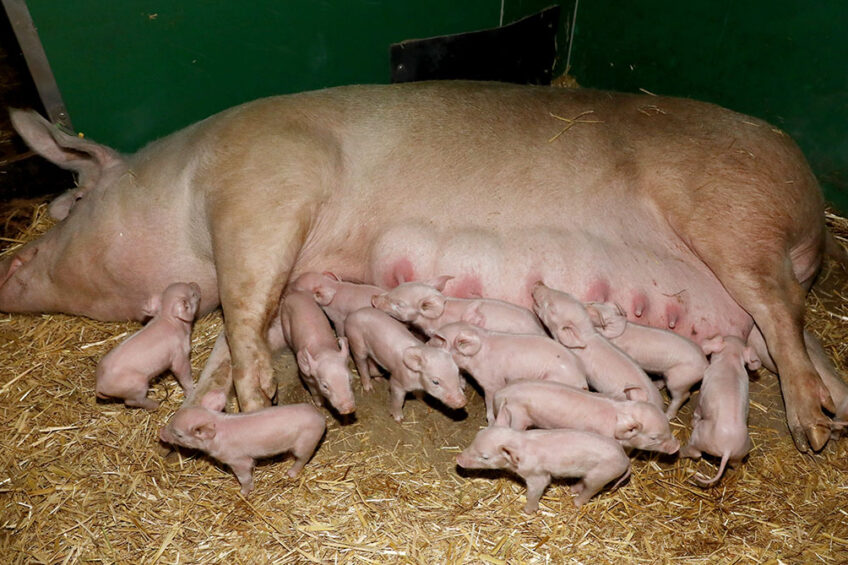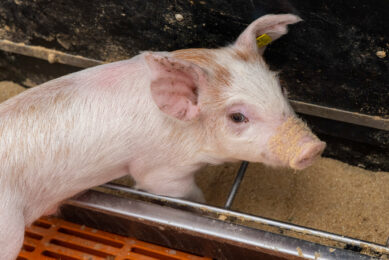Which tactics can resolve issues with low piglet birth weight?

Piglets with a low birth weight are an important cause of economic loss due to increased morbidity and mortality rates, and reduced growth performance, meat, and carcass quality. Therefore, nutritional strategies at sow and piglet levels are needed to prevent a low birth weight from occuring and to increase piglet survivability and growth rate.
Genetic selection for enhanced prolificacy has increased the number of piglets per litter, birth weight variation within litters, and the percentage of piglets with a low birth weight. It also increased post-natal survival over the last decades.
Piglets with a low birth weight
A newborn piglet with a birth weight below a 10th percentile of the mean birth weight of the litter, or a newborn piglet with a birth weight less than the mean birth weight minus up to 2 times the standard deviation is a low-birth weight piglet regardless of gestational age and time of delivery. Intrauterine growth restriction is highly prevalent in highly prolific sows with high ovulation rates. It also prevents some fetuses from meeting their genetically determined potential size due to uterine crowding.
Tackling low birth weight at the sow level
Overfeeding hyperprolific sows during the last weeks of gestation reduces embryonic death. Sows mobilise nutrients to support fetal development; thus, low energy supply has no adverse effects on piglets’ birth weight.
Supplementing the sow diet during late gestation with medium-chain fatty acids improves the survival of low-birth weight piglets during the post-natal period by increasing sow’s milk yield and quality. Long-chain polyunsaturated fatty acids such as fish oil in sow diets are essential for brain development, reduce pre-weaning mortality rates, increase post-natal piglet growth, and enhance suckling behaviour.
Supplementing monounsaturated fatty acids during the first half of gestation decreases the incidence of low-birth weight piglets due to an enhanced placental growth. Protein availability and a balanced amino acid profile during pregnancy are essential for optimal survival and growth of the offspring and litter uniformity.
Supplementing L-carnitine during the entire gestation period leads to balanced litter weights
Sows in early gestation require high amounts of threonine, whereas sows in late gestation require high amounts of arginine, glutamine, and leucine for fetal and mammary growth. Dietary supplementation of arginine increases placenta vascularisation, the number of live-born piglets, and the total litter weight. Supplementing L-carnitine during the entire gestation period leads to balanced litter weights, and increased birthweights due to enhanced placenta development and intrauterine fetal nutrition.
Tackling the issue at the piglet level
Colostrum contains nutrients and immunoglobulins providing the necessary elements and energy for metabolism, heat production, and passive immunity. Thus, sufficient colostrum consumption is critical for lthe survival of piglets with a low birth weight.
However, these piglets are less able to move towards the udder, compete for milk with heavier littermates, and ingest enough colostrum and milk. Feeding fermented potato protein and pectin residue during the last week of gestation increases colostrum production. Commercial booster preparations or colostrum substitutes for neonates can be used that contain supplemental energy, immunoglobulins, and growth factors.
Supplementing emulsion of medium- and long-chain triglycerides reduces the death hazard. It is recommended to reduce heat loss by using electric heat lamps and floor heat and to prevent piglets from being crushed by the sow immediately after farrowing.
In addition, practices such as split nursing, split weaning, and cross-fostering result in an increased and prolonged milk intake and catch-up growth of the lightest piglets during lactation and reduces pre-weaning mortality up to 40%. Intrauterine growth restriction prevents the development and maturation of the small intestine. Thus, decreasing the probability of optimal post-natal food intake and barrier function. Supplementing insulin-like growth factor-1 to neonatal formula-fed piglets stimulates small intestinal growth and maturation, increases crypt cell proliferation and villus heights, and elevates intestinal enzyme activities.
Further research is neccesary to better understand the amino acid requirements during different gestation phases
The exogenously administered epidermal growth factor increases intestinal brush border enzyme activities and has a healing effect on intestinal tissue damage. Adding leptin to the diet of formula-fed neonatal piglets during the first 7 days of life leads to longer small intestines and better nutrient absorption.
Concluding remarks
In modern intensive swine industry, selection for increased litter size leads to higher incidence of piglets with a low birth weight. Sow level approaches include optimising the intrauterine environment via supplementing additional lipids, functional amino acids, and providing diets with balanced amino acid profile during gestation period.
Piglet level approaches include both feeding and management strategies to keep piglets alive and ensure their satisfactory weight gain. However, further research is neccesary to better understand the amino acid requirements during different gestation phases and the differential development of low-birthweight piglets to accommodate their nutritional needs.











